Not in the mood to cook? Pressed for time in the morning? Ready-to-eat cereals can be a simple and convenient breakfast—or snack—option for people with chronic kidney disease (CKD). But navigating the cereal aisle can be overwhelming, and food labels aren’t always as helpful as they seem. That’s why we’ve done the work for you and created a list of kidney-friendly cereals that are low in sodium, low in potassium, relatively low in sugar, and free of phosphorus additives.
This post may contain affiliate links through which we may earn a small commission to help keep this website free.
Before we get to the list, let’s break down why these nutrients matter and how to make cereal part of your kidney-conscious eating plan.
Skip the ads: Kidney Foodie Academy members can access ALL of the Kidney Foodie Grocery Shopping Guides ad-free by visiting this section of the library. Not a member? Learn more about Kidney Foodie Academy here.
Table of contents
What makes a cereal kidney friendly?
Protein
Some people with CKD benefit from a lower protein diet, particularly in the later stages of kidney disease. Reducing protein can decrease the buildup of nitrogenous waste products in the blood and may also reduce pressure in the kidneys, which can help manage symptoms and slow progression. Talk to your doctor or dietitian about what the right amount of protein is for you.
Cereal is often lower in protein compared to eggs or meat-based breakfasts, which can make it a good option. There is also evidence that getting protein from plant sources (like cereal!) is more beneficial than protein from animal sources.
However, protein content can vary widely. Some high-protein cereals (like those marketed for athletes or weight loss) can have 10–15 grams per serving, while others have as little as 2–3 grams.
Keep in mind that what you pair cereal with also matters. Using a plant-based milk with minimal protein and adding fruit can create a lower-protein meal even if the cereal itself is a bit higher in protein. This flexibility can help you meet your protein needs for the day without going overboard.
Potassium
Potassium is an important mineral for nerve and muscle function, including keeping your heart beating regularly. For people with CKD, potassium management can be confusing. Some people need to restrict potassium, but many do not.
Unless your provider has told you otherwise, there’s no need to automatically restrict potassium. There are many things that can contribute to out-of-range potassium that are not related to the amount of potassium in foods that you eat. I walk through this in more depth in my free mini email course, 5 Ways to Control Potassium Without Avoiding High Potassium Foods. You can sign up for the free course here.
There is no single definition of a low-potassium food. Many people use a cut-off of 200mg of potassium per serving, but that can sometimes be overly restrictive. Here’s how we typically think of high and low potassium foods:
- If a food has less potassium (in milligrams) than it has calories, it’s likely very low in potassium.
- If it has about twice as much potassium as calories, it’s considered high potassium.
- Anything in between is moderate.
Using these definitions, most cereals would be considered low potassium (and none on my list would be considered high).
Sodium
Cereal might not be the first food that comes to mind when you think about sodium, but many boxed cereals can pack in more salt than expected. Sodium is added for shelf life and flavor, even in cereals that don’t taste obviously salty.
For people with CKD, managing sodium intake is essential for controlling blood pressure and reducing fluid retention. Elevated sodium intake can also increase the risk of heart disease—something people with CKD are already more vulnerable to. The National Kidney Foundation’s KDOQI nutrition guidelines recommend limiting sodium to under 2,300 mg per day, and many people may benefit from going even lower depending on their health goals.
An easy way to screen cereals is to compare sodium to calories. Look for cereals where the sodium (in milligrams) is lower than the number of calories per serving. For example, if a cereal has 110 calories, aim for less than 110 mg of sodium.
Phosphorus
Phosphorus is another nutrient to be mindful of when choosing a cereal, but it’s not as simple as looking at the nutrition label. While some cereals list total phosphorus content, this number doesn’t differentiate between natural phosphorus and phosphorus additives. And that matters—a lot. Phosphorus additives are much more readily absorbed (up to 90–100%) compared to natural sources (which are absorbed at much lower rates, around 30–60%).
High phosphorus levels can contribute to bone disease, cardiovascular complications, and worsening kidney function. However, it’s only the added forms we need to avoid. That’s why I recommend ignoring the phosphorus number on the label and instead checking the ingredients list. If you see anything with “phos” in it—like calcium phosphate, disodium phosphate, or phosphoric acid—that’s a sign it contains added phosphorus and should be avoided.
Added Sugars
Many cereals today are more like desserts than breakfast foods, especially the brightly colored ones targeted to kids—but even “healthy” cereals can have hidden sugars. High sugar intake increases the risk of weight gain, inflammation, and cardiovascular disease, which are all concerns for people with CKD.
Even without diabetes, it’s a good idea to keep added sugar in check. The American Heart Association recommends no more than 25 grams per day for women and no more than 36 grams per day for men. Aim for cereals with no more than 6 to 8 grams of added sugar per serving, and ideally less.
If you find lower sugar cereals too bland at first, try adding sliced bananas, blueberries, or a sprinkle of cinnamon for natural sweetness.
Iron
People with CKD are at increased risk for anemia due to reduced production of erythropoietin (a hormone that stimulates red blood cell production), frequent blood testing, inflammation, and potential nutrient shortfalls. Iron is one of the key nutrients that helps prevent anemia, and getting enough through food can help reduce the need for supplements or IV iron in some cases.
Some ready-to-eat cereals are fortified with iron and can be a convenient source—especially if your overall intake from other iron-rich foods (like meat, legumes, or leafy greens) is limited.
The Recommended Dietary Allowance (RDA) for iron is:
- Women aged 19–50: 18 mg/day
- Men aged 19 and older: 8 mg/day
- Women 51+ (postmenopausal): 8 mg/day
Fortified cereals often contribute 25% or more of the RDA in a single serving, which can help you meet your needs more easily. Just be sure the cereal doesn’t contain phosphate additives and fits within your sodium and sugar limits.
Fiber
Fiber is one of the most beneficial nutrients for kidney health, but it’s often overlooked. Getting enough fiber can help manage blood sugar, support a healthy gut microbiome, and can help you better manage potassium levels. There is even research showing that higher fiber diets are linked to lower inflammation and risk of mortality in people with kidney disease.
The goal for most adults is at least 25 grams per day, though most Americans fall short. Choosing cereals with at least 3 grams of fiber per serving is a good way to boost your intake, especially when combined with other high-fiber foods like fruit or whole grains.
Kidney Friendly Cereal You Can Buy
Kelloggs Frosted Mini-Wheats
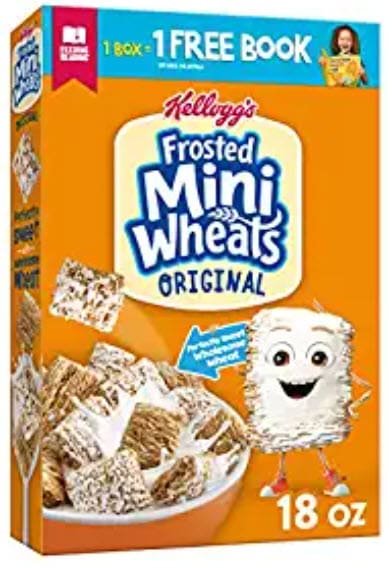
- Calories: 210
- Protein: 5g
- Carbohydrate: 51g
- Fat: 1.5g
- Sodium: 10mg
- Phosphorus
Additives: None - Potassium: 160mg
- Calcium: 0mg
- Fiber: 6g
- Sugar: 12g
Post Great Grains Raisins, Dates, & Pecans cereal
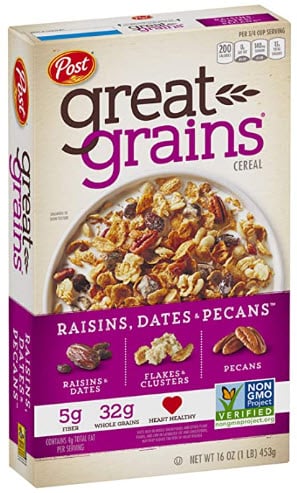
- Calories: 200
- Protein: 4g
- Carbohydrate: 40g
- Fat: 4g
- Sodium: 140mg
- Phosphorus
Additives: None - Potassium: 210mg
- Calcium: 20mg
- Fiber: 5g
- Sugar: 13g
Kashi Cereal

- Calories: 190
- Protein: 9g
- Carbohydrate: 36g
- Fat: 4g
- Sodium: 150mg
- Phosphorus
Additives: None - Potassium: 270mg
- Calcium: 60mg
- Fiber: 9g
- Sugar: 10g
Food for Life Ezekiel Cereal
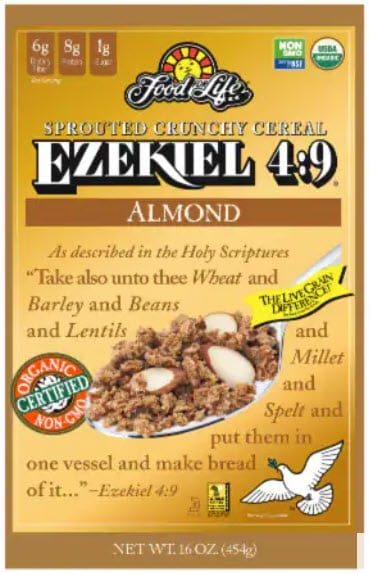
- Calories: 200
- Protein: 8g
- Carbohydrate: 34g
- Fat: 3g
- Sodium: 150mg
- Phosphorus
Additives: None - Potassium: 193mg
- Calcium: 23mg
- Fiber: 6g
- Sugar: 1g
Seven Sundays Cereal
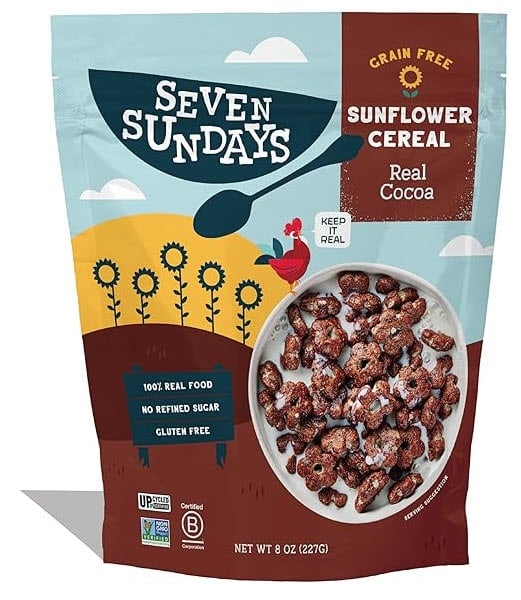
- Calories: 170
- Protein: 5g
- Carbohydrate: 27g
- Fat: 6g
- Sodium: 30mg
- Phosphorus
Additives: None - Potassium: 100mg
- Calcium: 20mg
- Fiber: 3g
- Sugar: 5g
Purely Elizabeth Cereal
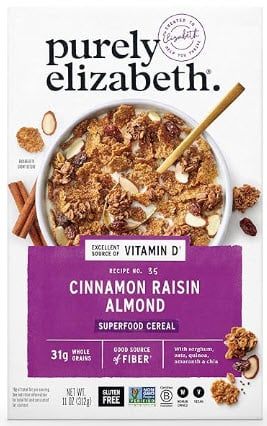
- Calories: 240
- Protein: 5g
- Carbohydrate: 38g
- Fat: 8g
- Sodium: 100mg
- Phosphorus
Additives: None - Potassium: 200mg
- Calcium: 40mg
- Fiber: 4g
- Sugar: 9g
Ratio Granola
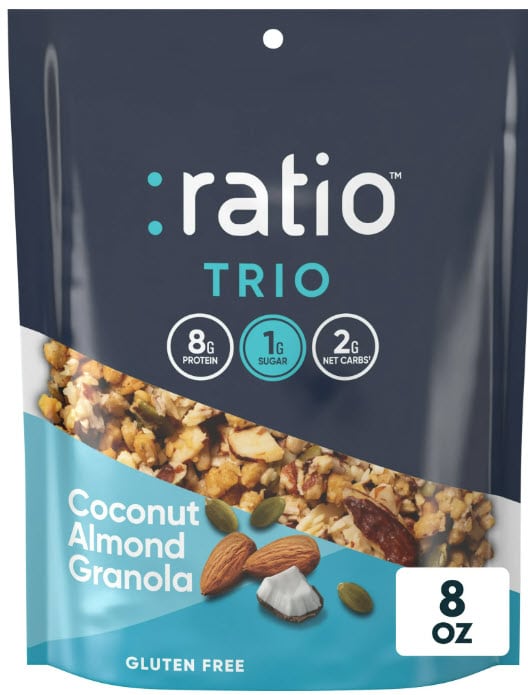
- Calories: 150
- Protein: 8g
- Carbohydrate: 7g
- Fat: 10g
- Sodium: 125mg
- Phosphorus
Additives: None - Potassium: 140mg
- Calcium: 60mg
- Fiber: 4g
- Sugar: 1g
Back to Nature Granola
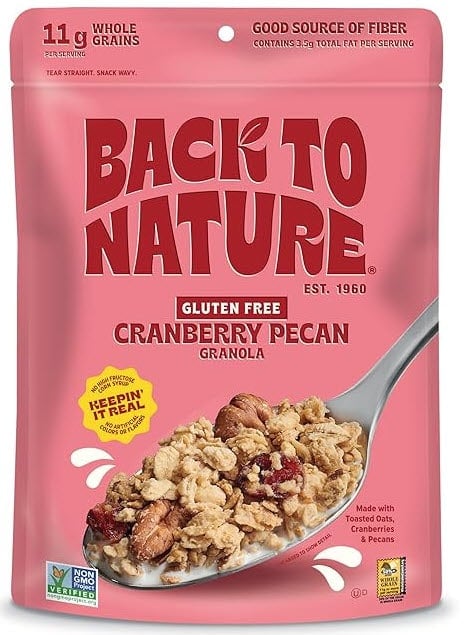
- Calories: 120
- Protein: 2g
- Carbohydrate: 19g
- Fat: 3.5g
- Sodium: 10mg
- Phosphorus
Additives: None - Potassium: 70mg
- Calcium: 10mg
- Fiber: 3g
- Sugar: 7g
Bear Naked
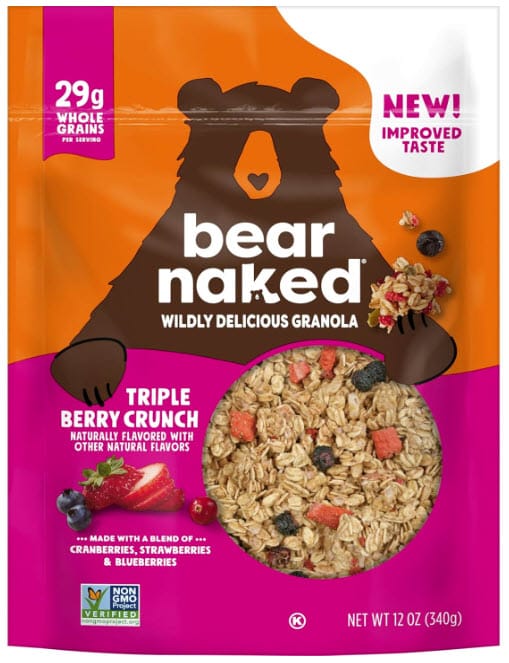
- Calories: 210
- Protein: 5g
- Carbohydrate: 40g
- Fat: 5g
- Sodium: 150mg
- Phosphorus
Additives: None - Potassium: 170mg
- Calcium: 30mg
- Fiber: 5g
- Sugar: 11g
Bob’s Red Mill Paleo Style Muesli
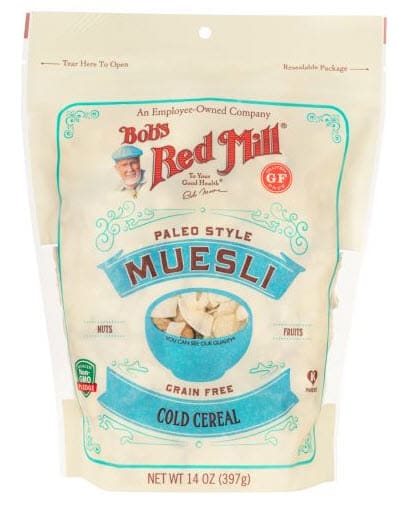
- Calories: 140
- Protein: 3g
- Carbohydrate: 9g
- Fat: 10g
- Sodium: 0mg
- Phosphorus
Additives: None - Potassium: 174mg
- Calcium: 13mg
- Fiber: 4g
- Sugar: 3g
Wildway Grain Free Granola Apple Cinnamon
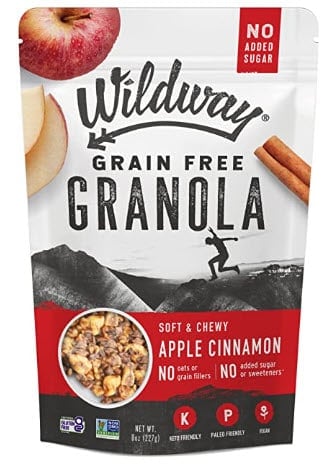
- Calories: 140
- Protein: 3g
- Carbohydrate: 12g
- Fat: 10g
- Sodium: 25mg
- Phosphorus
Additives: None - Potassium: 171mg
- Calcium: 23mg
- Fiber: 2g
- Sugar: 8g
Cascadian Farm Coconut Cashew Granola
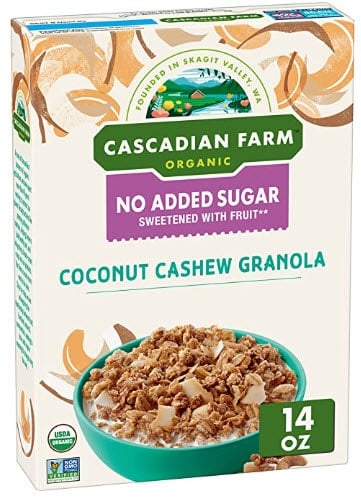
- Calories: 330
- Protein: 5g
- Carbohydrate: 37g
- Fat: 19g
- Sodium: 85mg
- Phosphorus
Additives: None - Potassium: 188mg
- Calcium: 0mg
- Fiber: 4g
- Sugar: 8g
Cascadian Farm Cinnamon Crunch
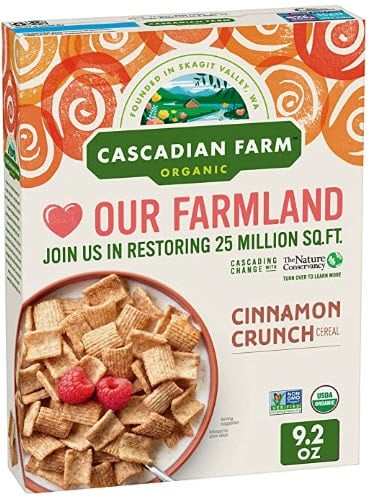
- Calories: 140
- Protein: 2g
- Carbohydrate: 29g
- Fat: 3g
- Sodium: 140mg
- Phosphorus
Additives: None - Potassium: 0mg
- Calcium: 0mg
- Fiber: 3g
- Sugar: 11g
Quaker Oatmeal Squares
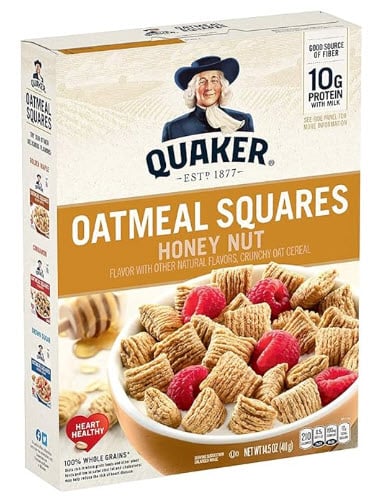
- Calories: 210
- Protein: 6g
- Carbohydrate: 44g
- Fat: 2.5g
- Sodium: 190mg
- Phosphorus
Additives: None - Potassium: 200mg
- Calcium: 30mg
- Fiber: 5g
- Sugar: 10g
Shredded Wheat Cereal
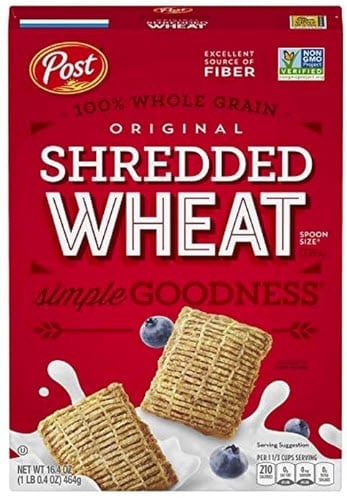
- Calories: 210
- Protein: 7g
- Carbohydrate: 49g
- Fat: 1g
- Sodium: 0mg
- Phosphorus
Additives: None - Potassium: 210mg
- Calcium: 20mg
- Fiber: 8g
- Sugar: 0g
Runner Ups
These cereals didn’t quite meet our stringent requirements, but may still be good options.
Post Honey Bunches of Oats Cinnamon Bunches
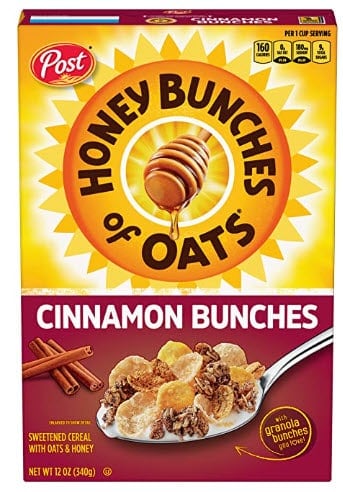
- Calories: 160
- Protein: 3g
- Carbohydrate: 34g
- Fat: 2g
- Sodium: 180mg
- Phosphorus
Additives: None - Potassium: 80mg
- Calcium: 10mg
- Fiber: 2g
- Sugar: 9g
Kellogg’s Raisin Bran Crunch
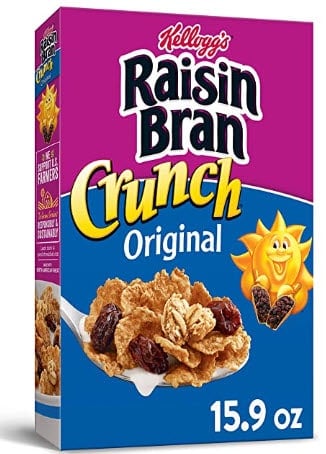
- Calories: 190
- Protein: 4g
- Carbohydrate: 46g
- Fat: 1g
- Sodium: 200mg
- Phosphorus
Additives: None - Potassium: 280mg
- Calcium: 20mg
- Fiber: 4g
- Sugar: 19g
Quaker Life Cereal

- Calories: 160
- Protein: 4g
- Carbohydrate: 33g
- Fat: 2g
- Sodium: 170mg
- Phosphorus
Additives: None - Potassium: 110mg
- Calcium: 160mg
- Fiber: 3g
- Sugar: 10g

